Read Time: 5 Minutes Subscribe & Share
Gloom Cuisine
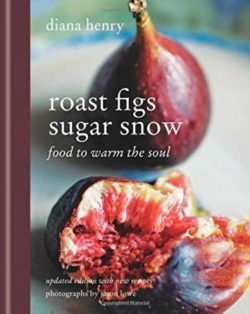 Winter technically occupies only the months of December, January and February. Personally, December is always full of caking and baking, giving and receiving so it passes with joy and the reading of new cookbooks. Then January arrives and you know that you are in for a long dreary haul. And since I read cookbooks to arrive at my happy place, there are certain ones I only pick up at certain times of the year. Roast Figs Sugar Snow by Diana Henry is one that I save for reading and cooking starting only in January But why are we talking about this in March, Nancy?
Winter technically occupies only the months of December, January and February. Personally, December is always full of caking and baking, giving and receiving so it passes with joy and the reading of new cookbooks. Then January arrives and you know that you are in for a long dreary haul. And since I read cookbooks to arrive at my happy place, there are certain ones I only pick up at certain times of the year. Roast Figs Sugar Snow by Diana Henry is one that I save for reading and cooking starting only in January But why are we talking about this in March, Nancy?
Well to me, March is the month of The Forlorn Hope. Technically it is Spring, but it remains (at least here in Alexandria, Virginia) wintry, gray, with occasional uprisings of Spring weather followed by a cold snap, flurries and slush. This particular book gives me great solace and ideas to create seasonal meals in the year’s most difficult quarter. Diana Henry is also the most indefatigable of authors who has a virtual snowbank of cookbook titles, and I am the happy owner of several. Her recipes are like little adventures. Not every recipe suits the other eater in the house, and some I have had to fiddle with a bit more, probably due to my stove or the ingredients I have available to me (cream and good seafood here are two of my bêtes noires).
Comfort Me With Cooking
Even the aesthetics of the book reflect winter in a pleasing way. Each section has two or three pages of lovely prose by Diana reflecting her experiences in gathering the recipes, as well as some far-flung traditions of this most difficult season for food. I even like the photographs and the page colors, wintry but soothing. And she does forewarn you that certain dishes will require a serious walk or outdoor exercise before serving. But then, I figure it is well deserved after I have walked a few miles along the river, or shoveled and swept the slush and dead leaves in front of our home and down our long alley. She also writes a food column for The Telegraph and is a broadcaster for the BBC, If you don’t have access to either of those press venues, subscribe to her Instagram feed which has one of her dishes in glorious detail Monday through Friday. Spoiler alert – there is always a dessert on Friday.
experiences in gathering the recipes, as well as some far-flung traditions of this most difficult season for food. I even like the photographs and the page colors, wintry but soothing. And she does forewarn you that certain dishes will require a serious walk or outdoor exercise before serving. But then, I figure it is well deserved after I have walked a few miles along the river, or shoveled and swept the slush and dead leaves in front of our home and down our long alley. She also writes a food column for The Telegraph and is a broadcaster for the BBC, If you don’t have access to either of those press venues, subscribe to her Instagram feed which has one of her dishes in glorious detail Monday through Friday. Spoiler alert – there is always a dessert on Friday.
Not A Rutabaga In Sight
 I have been accused by the in-house culinary jury of being a relentless root vegetable cook in the winter. So just to reassure you, Roast Figs Sugar Snow does not include rutabagas and only has one recipe for Jerusalem artichokes – ditto parsnips. The book is divided up into sections based on available vegetables and fruits, including the expected presence of squashes, dried beans, pork and game, nuts, and mushrooms and thank goodness – cheese, and cream in all its guises. And surprise, surprise, Diana Henry fell in love with North American Maple Syrup and ends with several recipes including one I want to share with my grandsons – Maple Sugar On Snow.
I have been accused by the in-house culinary jury of being a relentless root vegetable cook in the winter. So just to reassure you, Roast Figs Sugar Snow does not include rutabagas and only has one recipe for Jerusalem artichokes – ditto parsnips. The book is divided up into sections based on available vegetables and fruits, including the expected presence of squashes, dried beans, pork and game, nuts, and mushrooms and thank goodness – cheese, and cream in all its guises. And surprise, surprise, Diana Henry fell in love with North American Maple Syrup and ends with several recipes including one I want to share with my grandsons – Maple Sugar On Snow.
Both my husband and I do not have happy memories of cabbage during the “cold times”. His mother could make a passable southern coleslaw and would served braised cabbage wedges with canned corned beef hash during economically hard times. My mother tried a few times with cooked cabbage but it was soon removed from her dinner offerings. While I have recreated (mostly French) successful dishes of braised cabbage, this one is so quick, and so delicious with just juniper, garlic and butter, that it has remained a favorite during the JanFebs. So before I put this book away for January 2022, these were three favorite discoveries.
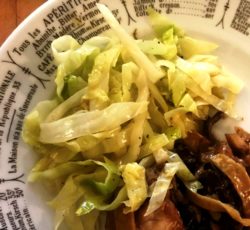

- Savoy cabbage 675gr or 1.5lbs
- 8 juniper berries
- 1 big garlic clove, peeled.
- 1/4 cup (57gr) butter salted or unsalted, you will correct the seasoning at the end.
- sea salt and freshly ground pepper
- 1/4 cup (60ml) water to add to pot.
- Halve the cabbage and cut out the core.
- Shred the cabbage into 3/4 inch or 2cm slices with a knife or mandoline.
- Rinse the shredded cabbage and drain in a sieve or colander.
- Crush the juniper berries and the garlic together in a mortar and pestle.- you may want to cut the garlic in slices to facilitate this.
- Melt the butter in a heavy pan that can comfortably fit the amount of cabbage you have shredded.
- Add the cabbage, crushed juniper and garlic, salt and pepper, and about 1/4 cup (60ml) water
- Adjust the heat to low, cover and cook the cabbage for 4 minutes, shaking it vigorously after a minute and then again.
- Stir the buttery juices to coat the cabbage, seasion to taste, and serve immediately.
Rabbit is a cold weather favorite here. Although I have learned early in parenthood not to serve it at Easter. It is a sustainable protein as they like to say in 21st century food parlance. You can use any combination of dried mushrooms you like, but I love the addition of dried morels. She suggests an egg pasta, but polenta or mashed potatoes are both nice alternatives.
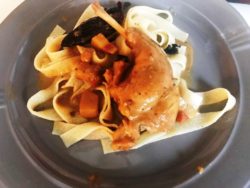

- 1 oz or 30 grams dried wild mushrooms - I use morels, chanterelles and Trompettes de la Mort
- 2 tablespoons ((28gr) unsalted butter
- sea salt and freshly ground pepper
- 5 1/2 oz (150gr) bacon, pancetta or guanciale diced into 1/2 inch (1cm) cubes
- 1 rabbit cut into 8 pieces
- 1 large yellow onion coarsely diced
- 2 teaspoons (5gr) white all purpose flour.
- 2/3 cup (158ml) white wine
- 1 1/4cup (296ml) well flavored chicken stock ( I use a roasted chicken stock)
- 2 bay leaves (fresh is better)
- 3 springs fresh thyme
- 1 1/4 cups (306gr) sour cream - I use half sour cream and half creme fraiche
- Boil around 2-3 cups of water to pour onto the dried mushrooms
- Pour enough boiling water just to cover the mushrooms in a bowl.
- Allow them to soak for at least 15 minutes - I soak mine longer to make sure they are all softened.
- Meanwhile melt the butter in a large saute pan or casserole on top of the stove.
- Season the rabbit pieces with salt and pepper and cook them on all sides until they are just golden - you do not want a dark sear.
- Remove the rabbit pieces and add the diced bacon or pancetta or guanciale until they are just golden and then add the onion and cook until soft, but not colored.
- Stir in the flour and mix well, then add the wine, stock and strain the mushroom soaking "liquor".
- Cut up any mushrooms that have swelled up to a very large size and then add all of them in.
- Bring this to a boil, and then lower to a simmer before adding the rabbit pieces.
- Add the herbs and taste to season.
- Cook over a gentle heat, uncovered, until the rabbit is just cooked through and the liquid is reduced.
- Rabbit should be still moist but not bloody near the bone.
- Whisk in the sour cream (I have to use half creme fraiche and half sour cream as the sour cream I get here is so grainy when cooked) - only cook for less than 5 minutes and do net let it boil.
- Serve with any egg noodles of your choice.
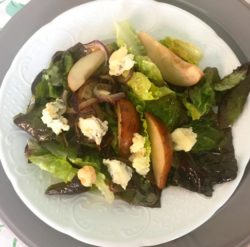 I love salads in any month and always search for interesting ones in the winter. And this book has several, including one that I have made for several winters, which Henry calls a Farmer’s Winter Salad with blood sausage (I can get really good Morcilla from Butcher’s Alley), potatoes, pancetta and fried egg – with a not too intrusive sprinkling of salad leaves but with a different dressing to the one you make for this salad. My husband likes salad if it has some distractions in it (and always a child portion) This one has been a winter pleaser with its sautéed pears, toasted hazelnuts, caramelized onions and Cashel Blue Cheese from Ireland, which is milder than its French cousin, Roquefort. If you can, purchase the Italian hazelnuts from the province of Piedmont, they are a very tasty alternative to our domestic ones.
I love salads in any month and always search for interesting ones in the winter. And this book has several, including one that I have made for several winters, which Henry calls a Farmer’s Winter Salad with blood sausage (I can get really good Morcilla from Butcher’s Alley), potatoes, pancetta and fried egg – with a not too intrusive sprinkling of salad leaves but with a different dressing to the one you make for this salad. My husband likes salad if it has some distractions in it (and always a child portion) This one has been a winter pleaser with its sautéed pears, toasted hazelnuts, caramelized onions and Cashel Blue Cheese from Ireland, which is milder than its French cousin, Roquefort. If you can, purchase the Italian hazelnuts from the province of Piedmont, they are a very tasty alternative to our domestic ones.
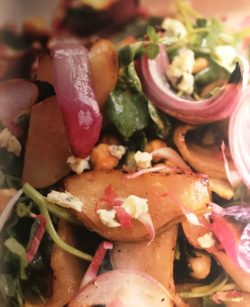

- 1 small red onion
- Olive oil
- sea salt and freshly ground pepper
- 3 pears - not too ripe
- 2 tablespoons (28gr) unsalted butter
- 1/2 cup (65gr) whole hazelnuts unpeeled or peeled, lightly toasted
- 5 1/2 oz (150gr) mixture of small salad leaves
- 6 oz (175gr) Cashel Blue Cheese, crumbled
- 2 1/2 teaspoons (12ml) white wine vinegar
- 1/2 teaspoon (11gr) Dijon mustard
- 1/4 cup (60ml) hazelnut oil
- 2 tablespoons (30ml) light flavored Extra Virgin olive oil
- 1 teaspoon (4gr) caster sugar (or to taste)
- Preheat oven to 350F (175C)
- Halve the red onion and cut into crescent shaped slices.
- Put them into a small ovenproof dish, drizzle with olive oil, season with salt and pepper.
- Roast them in the oven until soft and lightly caramelized - time varies from 15 minutes to 30 minutes.
- Keep them warm while making the dressing, which is simply whisking all the ingredients together in a small bowl and adjusting the salt and pepper when you’ve finished the dressing.
- Halve and scoop out the core and seeds of the pears = they are not peeled - and then cut them into slices 1/4 inch (3/4cm) thick.
- Melt the butter in a skillet and quickly saute the pear slices on each side until golden.
- Do not overcook, they should still hold their shape and not be too soft.
- Toss the salad leaves with the nuts in the dressing, leaving some to garnish the finished salad.
- Divide the leaves among 6 salad plates and add the pear slices and onion slivers.
- Scatter the crumbled cheese across each serving and drizzle with a bit of the remaining dressing.
- My favorite Hazelnut Oil is produced by J. LeBlanc in France.

Kitchen Detail shares under the radar recipes, explores the art of cooking, the stories behind food, and the tools that bring it all together, while uncovering the social, political, and environmental truths that shape our culinary world.




Happy Spring Nancy!
Rejoice! we are almost out of the doldrums. Bright yellow crocuses have bravely bloomed in our yard emerging from under the thick layers of ice that covered them, just last week.
Thanks for another great article, the name Diana Kennedy sounded very familiar so went to my cookbooks and found “The Tortilla Book” (1975) and my favorite, “The Cuisines of Mexico” (1986, 1972). Could this be the same Diana Kennedy you cited? You also provided the first cabbage recipe that I actually will make before another petite choux perishes in the fridge. Much appreciated!
Best, Tori
Hi Tori,
I did write about Diana Kennedy in another post:
https://lacuisineus.com/food-in-film-nothing-fancy-with-diana-kennedy/
Both Diana Henry and Diana Kennedy are marvelous and inspirational food writers.
Nancy